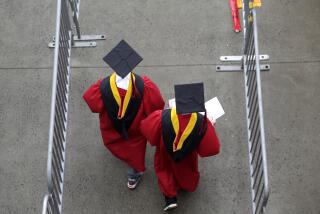Why We Should Give Thanks for the Things Public Schools Offer
- Share via
Many of us will take some time today to ponder the things we appreciate in life. I hope you will include public schools on your list of things to be thankful for.
There are always plenty of things to carp about in American public education, and there probably always will be. Today, though, you get my annual pitch about the good things.
Some of these good things are described in a recent report, “Perspectives on Education in America,” prepared by Sandia, an independent research group based in New Mexico.
For example, high school students aren’t as lazy and unskilled as some curmudgeons claim. The percentage of Americans who graduate from high school has risen throughout this century, from 10% in 1910 to about 80% in 1990--and the current figure is even higher than that if you count the dropouts who return to pass the General Education Development (GED) test. Japan’s rate, by comparison, is about 87%.
The dropout rate, meanwhile, has decreased steadily. The trend is especially encouraging among black youths, whose dropout rate was below 15% in 1990, compared to 27% in 1970.
There is also good news about Scholastic Aptitude Test (SAT) scores.
Most news reports focus on the national average SAT score. This can be misleading, because in the past decade the SAT has become more accessible; more students from lower-performing groups have been added to the traditional group of test-takers.
In truth, since 1980, every subpopulation taking the SAT has shown improvement. And the traditional SAT-takers (white, college-bound, middle-class students) improved their scores from about 900 in 1975 to about 975 in 1990.
Be thankful for a few milestones in college and university education too.
For one, the United States has the world’s highest percentage of people with four-year degrees. That percentage continues to grow. It was 5% in 1940, 20% in 1980, and 25% in 1990.
In fact, about three of every five U.S. students attempt some kind of post-secondary schooling. That’s twice the number as in Japan.
We also have a more equitable gender distribution of degree-holders too.
A lot is said and written about how technologically unprepared our graduates are.
But since 1977, the number of college degrees in math, computer science, physical science and engineering has risen more than 75%. Asian Americans, blacks, Latinos and Native Americans have swelled their representation in these fields.
Finally, ponder this: The average American public school teacher has a master’s degree or more; the average Japanese teacher has a bachelor’s degree or less, but is paid 50% more than his or her American counterpart.
So give some thanks, too, for that incredible bargain known as the American public school teacher.
Mary Laine Yarber teaches English at Santa Monica High School.






